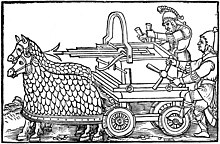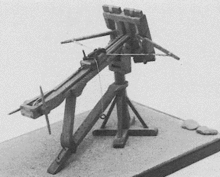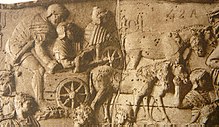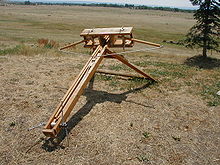Source: http://en.wikipedia.org/wiki/Ballista
Ballista
 | |
| This article is part of the series on: Military of ancient Rome (portal) 753 BC – AD 476 | |
| Structural history | |
|---|---|
| Roman army (unit types and ranks, legions, auxiliaries, generals) | |
| Roman navy (fleets, admirals) | |
| Campaign history | |
| Lists of wars and battles | |
| Decorations and punishments | |
| Technological history | |
| Military engineering (castra, siege engines, arches, roads) | |
| Personal equipment | |
| Political history | |
| Strategy and tactics | |
| Infantry tactics | |
| Frontiers and fortifications (limes, Hadrian's Wall) | |
The ballista (Latin, from Greek βαλλίστρα - ballistra[1] and that from - βάλλω ballō, "throw"),[2] plural ballistae, was an ancient missile weapon which launched a large projectile at a distant target.
Developed from earlier Greek weapons, it relied upon different mechanics, using two levers with torsion springs instead of a prod, the springs consisting of several loops of twisted skeins. Early versions ejected heavy darts or spherical stone projectiles of various sizes for siege warfare. It developed into a smaller sniper weapon, the Scorpio,[3] and possibly the polybolos.
Contents[hide] |
[edit] Greek weapon
The early ballista in Ancient Greece was developed from two weapons called oxybeles and gastraphetes. The gastraphetes ('belly-bow') was a hand held crossbow. It had a composite prod and was spanned with both hands, with a ratchet preventing it from shooting while loading. The power available was not sufficient to be used successfully against armoured troops. The oxybeles was a bigger and heavier construction employing a winch, and was mounted on a tripod. It had a lower rate of fire and was used as a siege engine.
With the invention of torsion spring bundle technology, the first ballista was built. The advantage of this new technology was the fast relaxation time of this system. Thus it was possible to shoot lighter projectiles with higher velocities over a longer distance.
For an oxybeles, the rules of a torsion weapon demanded that the more energy could be stored, the thicker the prod had to be and the heavier the projectile, to increase the amount of stored energy delivered to the projectile. The earliest form of the ballista is thought to have been developed for Dionysius of Syracuse, circa 400 BC.
The Greek ballista was a siege weapon. All components that were not made of wood were transported in the baggage train. It would be assembled with local wood, if necessary. Some were positioned inside large, armored, mobile siege towers or even on the edge of a battlefield. For all the tactical advantages offered, it was only under Philip II of Macedon and even more so under his son Alexander, that the ballista began to develop and gain recognition as both siege engine and field artillery. Polybius reports about the usage of smaller more portable ballistae, called scorpions, during the Second Punic War.
Since these weapons delivered lighter munitions (thus delivering less energy on impact) it is a widely held opinion that they were used more as a anti-personnel role, or to destroy lighter structures. A less accurate weapon like an onager or other single-arm artillery could hit with more force, and thus would be the more useful weapon against reinforced wood or heavy masonry.
Ballistae could be easily modified to shoot both spherical and shaft projectiles, allowing their crews to adapt easily to prevailing battlefield situations in real time.
As the role of battlefield artillery became more sophisticated, a universal joint (which was invented just for this function) was integrated into the ballista's stand, allowing the operators to alter the trajectory and firing direction of the ballista as required without a lengthy disassembly of the machine.

[edit] Roman weapon
After the absorption of the Ancient Greek city-states into the Roman Republic in 146 BC, the highly advanced Greek technology began to spread across many areas of Roman influence. This included the hugely advantageous military advances the Greeks had made (most notably by Dionysus of Syracuse), as well as all the scientific, mathematical, political and artistic developments.
The Romans 'inherited' the torsion powered Ballista, which had by now spread to several cities around the Mediterranean, all of which became Roman spoils of war in time, including one from Pergamum, which was depicted among a pile of 'trophy' weapons in relief on a balustrade.
The torsion ballista, developed by Alexander, was a far more complicated weapon than its predecessor and the Romans developed it even further, especially into much smaller versions, that could easily be carried.
[edit] Early Roman ballistae
The early Roman ballistae were made of wood, and held together with iron plates around the frames and iron nails in the stand. The main stand had a slider on the top, into which were loaded the bolts or stone shot. Attached to this, at the back, was a pair of 'Winches' and a 'Claw', used to ratchet the bowstring back to the armed firing position.
The slider passed through the field frames of the weapon, in which were located the torsion springs (rope made of animal sinew), which were twisted around the bow arms, which in turn were attached to the bowstring.
Drawing the bowstring back with the winches twisted the already taut springs, storing the energy to fire the projectiles. The bronze or iron caps, which secured the torsion-bundles were adjustable by means of pins and peripheral holes, which allowed the weapon to be tuned for symmetrical power and for changing weather conditions.
The ballista was a highly accurate weapon (there are many accounts of single soldiers being picked off by ballista operators), but some design aspects meant it could compromise its accuracy for range. The maximum range was over 500 yards (460 m), but effective combat range for many targets was far shorter. The ballista's relatively lightweight bolts also did not have the high momentum of the stones thrown by the later onagers, trebuchets, or mangonels; these could be as heavy as 200-300 pounds (90–135 kg).
The Romans continued the development of the Ballista, and it became a highly prized and valued weapon in the army of the Roman Empire.
It was used, just before the start of the Empire, by Julius Caesar during his conquest of Gaul and on both of his campaigns in subduing Britain. Both attempted invasions of Britain and the siege of Alesia are recorded in his own Commentarii (journal), The Gallic Wars (De Bello Gallico).
[edit] First invasion of Britain
The first invasion of Britain took place in 55 BC, after a rapid and successful initial conquest of Gaul, in part as an exploratory expedition to see the land across the sea, and more practically to try and put an end to the reinforcements sent across by the native Britons to fight the Romans in Gaul.
A total of eighty transports, carrying two legions, attempted to land on the British shore (the eighteen accompanying cavalry transports had been blown off course on the way over), only to be driven back by the many British warriors assembled along the shoreline. The ships had to unload their troops on the beach, as it was the only one suitable for many miles, yet the massed ranks of British charioteers and javeliners were making it impossible.
Seeing this, Caesar ordered the warships – which were swifter and easier to handle than the transports, and likely to impress the natives more by their unfamiliar appearance – to be removed a short distance from the others, and then be rowed hard and run ashore on the enemy’s right flank, from which position the slings, bows and artillery could be used by men on deck to drive them back. This manoeuvre was highly successful.
Scared by the strange shape of the warships, the motion of the oars, and the unfamiliar machines, the natives halted and then retreated a little. (Caesar, The Conquest of Gaul, p99)
[edit] Siege of Alesia
In Gaul, the stronghold of Alesia was under a Roman siege in 52 BC, and was famously almost completely surrounded by a fourteen mile (21 km) long trench filled with water diverted from the local river, then another trench, then a wooden palisade and towers, then the besieging Roman army, then another series of palisades and trenches to protect them from any Gallic relief forces. As was standard siege technique at the time, small ballistae were placed up in the towers as snipers and other troops armed with either bows or slings.


[edit] Ballistae in the Roman Empire
During the days of the conquest of Empire, the ballista proved its worth many times, in sieges and battles, on ships and on the land. It was even used to quell riots. It is from the time of the Roman Empire that many of the archaeological finds of ballistae date and in these times that many of the authors, whose technical manuals and journal accounts used by archaeologists to reconstruct these weapons, wrote their accounts.
After the time of Julius Caesar, the ballista was a permanent fixture in the Roman Army and, over time, modifications and improvements were made by successive engineers. This included replacing the remaining wooden parts of the machine with metal, creating a much smaller and lighter machine, capable of even more power than the wooden version, since the metal was not liable to snap like the wood, and which required less maintenance (though the vital torsion springs were still vulnerable to the rain).
[edit] Cheiroballistra / Manuballista
The Cheiroballistra and the Manuballista (hereafter Manuballista) are held by many archaeologists to be the same weapon.[citation needed] The difference in names comes from the different languages spoken in the Empire. Latin remained the official language in the Western Empire, but the Eastern Empire predominantly used Greek, which added an extra 'r' in the word Ballista.
The Manuballista was a handheld version of the traditional Ballista. This new version was made entirely of iron, which conferred greater power to the weapon, since it was smaller, and less iron, an expensive material before the 19th century, was used in its production. It was not the ancient Gastraphetes, but the Roman weapon. However, the same physical limitations applied as with the Gastraphetes.
[edit] Carroballista
The Carroballista was a cart-mounted version of the weapon. Probably there were different models of this cart-mounted ballista of the Cheiroballistra Class, at least 2 different models with 2 wheels and 1 model with 4 wheels. Probable size 1.47 m width, i.e. 5 Roman Feet. The cart system and structure gave it a great deal of flexibility and much more ability as a battlefield weapon, since the increased maneuverability allowed it to be moved with the flow of the battle. This weapon features several times on Trajan's Column.
[edit] Polybolos
According to some sources, the Roman military, at one time in its history, also fielded 'repeating' ballistae, also known as a polybolos. Reconstruction and trials of such a weapon carried out in a BBC documentary 'What the Romans Did For Us' showed that they "were able to shoot eleven bolts a minute, which is almost four times the rate at which an ordinary ballista can be operated".[4] However, this has not yet been found archaeologically. They operate using a cam to pull the mensa (the place where the projectile travels on) backwards and the string along with it. At the rearmost position, the string is unlocked and propels the projectile forwards. The mensa is then pushed forward and pushes a bolt out of the magazine above it, and latches on to the string, all done with the rotating cam. The cycle then repeats.
[edit] Archaeology and the Roman ballista
Archaeology, and in particular Experimental archaeology has been particularly influential on this subject. Although several ancient authors (such as Vegetius) wrote very detailed technical treatises, providing us with all the information necessary to reconstruct the weapons, all their measurements were in their native language and therefore highly difficult to translate.
Attempts to reconstruct these ancient weapons began at the end of the 19th century, based on the rough translations of these ancient authors. It was only during the 20th century, however, that many of these reconstructions began to make any sense as a weapon. By bringing in modern engineers, progress was made with the ancient measurement systems. By redesigning the reconstructions using the new information, archaeologists in the field were able to recognize certain finds from Roman military sites, and identify them as ballistae. The information learned from the excavations then went back into the next generation of reconstructions and so on.
Sites across the empire have yielded information on ballistae, from Spain (the Ampurias Catapult), to Italy (the Cremona Battleshield, which proved that the weapons had decorative metal plates to shield the operators), to Iraq (the Hatra Machine) and even Scotland (Burnswark siege tactics training camp), and many other sites between.
The most influential archaeologists in this area have been Peter Connolley and Eric Marsden, who have not only written extensively on the subject but have also made many reconstructions themselves and have refined the designs over many years of work.
[edit] Middle Ages
With the decline of the Roman Empire, resources to build and maintain these complex machines became very scarce, so the ballista was supplanted by the simpler and cheaper onager and the more efficient springald.
Though the weapon continued to be used in the Middle Ages, it faded from popular use with the advent of the trebuchet and mangonel in siege warfare. The crossbow and the longbow supplanted it as sniper weapon. They all were simpler to make, easier to maintain (no anointment) and much cheaper.
[edit] See also
--
Posted By Blogger to FireHeart - Exploring Worlds of Fantasy at 11/16/2010 07:45:00 PM











No comments:
Post a Comment